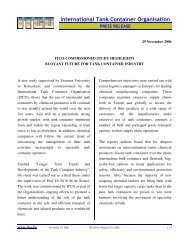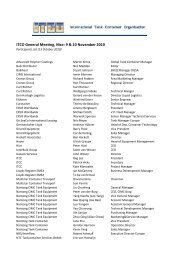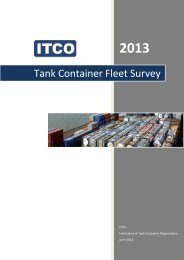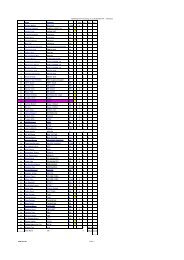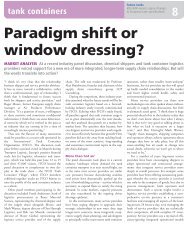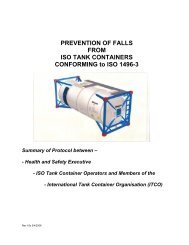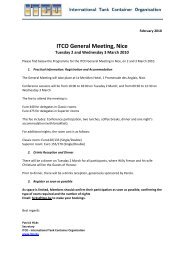You also want an ePaper? Increase the reach of your titles
YUMPU automatically turns print PDFs into web optimized ePapers that Google loves.
ICHCA International <strong>Safe</strong>ty Panel Briefing Pamphlet No 30<br />
steam is used and the shell not allowed to cool down to ambient<br />
temperature before it is closed.<br />
A6.1.4.3 The air line valve may also be used as a venting valve to allow air into the<br />
tank to prevent implosion during discharge by pump. Care has to be taken if<br />
this method <strong>of</strong> preventing implosion is used to ensure that the flow <strong>of</strong> air<br />
through the valve’s small diameter is sufficient, otherwise implosion can still<br />
occur.<br />
A6.1.4.4 If discharge has taken place using a pressurising medium, the shell will<br />
remain under pressure unless steps are taken to relieve the residual<br />
pressure. Attempting to open a manway lid on a shell under pressure is an<br />
extremely dangerous practice. It may be safer to relieve the residual<br />
pressure by opening the airline valve instead, even though this is a slower<br />
process.<br />
A6.1.4.5 Pressure gauges may be fitted to airline valves and vapour return lines on<br />
top discharge tanks. These gauges should not be confused with the tell tale<br />
gauges fitted in the void between an in series bursting disc and press relief<br />
valve.<br />
A6.1.5 Vapour Return<br />
A6.1.5.1 Some dangerous goods are so dangerous that either to have the tank open<br />
for filling or discharge or, for example, to vent any excess pressure in the<br />
shell from the pressurising medium to atmosphere, may be extremely<br />
dangerous as the escaping vapour may be a mixture <strong>of</strong> highly toxic or<br />
corrosive vapours and the pressurising medium. Nevertheless, the excess<br />
pressure or creation <strong>of</strong> partial vacuum conditions when loading and<br />
unloading these substances must be controlled. The solution is a closed<br />
(vapour recovery) system with more than one valve fitted which allows<br />
greater flexibility in load and discharge arrangements<br />
A6.1.5.2 In the same area as the valve over the siphon pipe there will usually be at<br />
least two other valves – see the two valves to the right in Picture 24. They<br />
may have the same diameter or one may be larger than the other. One<br />
valve will be intended to be used either for filling with a pipe or hose<br />
temporarily bolted onto the flange once the covering plate has been<br />
removed or as a vapour return line. The second valve is intended to be used<br />
either as connection for pressure discharge or it, too, may be used as a<br />
vapour return line.<br />
A6.1.5.3 Particularly when discharging is taking place, the tank container is in need <strong>of</strong><br />
vapour to replace the displaced liquid or implosion may occur. On the other<br />
hand, the receiving storage tank suffers a pressure increase as the liquid<br />
level rises with consequent risk <strong>of</strong> bursting. The situation is balanced using<br />
the vapour return line to divert the unwanted vapour from the storage tank<br />
into the tank container.<br />
A6.1.5.4 When loading or discharging top discharge tanks using close circuit<br />
systems, consideration should always be given to fitting non-return valves at<br />
suitable points in the lines. These are not normally provided on the tank<br />
containers themselves.<br />
Page 69 ©ICHCA International Limited



